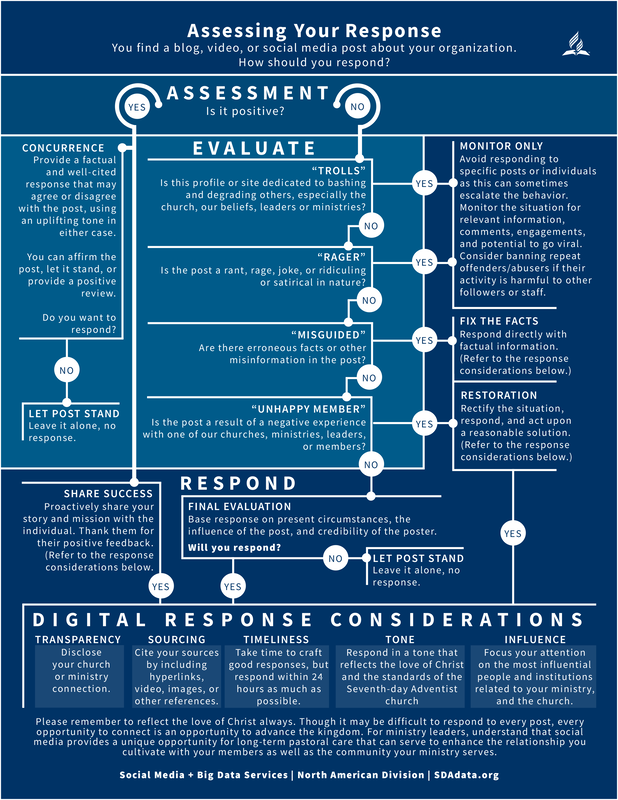Jamie Jean Schneider DommDigital Strategist, Social Media + Big Data, North American Division Only 20% of Americans regularly attend church, and only 2 in 10 millennials consider regular church attendance important. The Church no longer has the option of embracing change or leaving it to the next generation. The time is now; otherwise, we will become irrelevant. Change is never easy, but anything is possible with the Lord (see Matthew 19:26).
People search online for answers to their problems. They turn to the internet for companionship, understanding, information, anonymity, and more. We must be the voice that answers back, online, to share our message of hope and wholeness. Our digital presence may be the only exposure to the Gospel many people receive. We must recognize that the mission field is online, and just as legitimate as traditional evangelism. We need an army of digital evangelists dedicated to carrying the gospel to the digital mission field. Here are 5 steps you can take to become a digital evangelist with resource links:
Jesus sought first to fulfill people’s needs; He then invited them to follow. We can use social media and digital tools to achieve our mission of spreading the gospel and helping people by creating content that focuses on mental, physical, and spiritual needs first. Once this foundation is established, we can invite our audience to “taste and see that the Lord is good” (Psalm 34:8, NIV). When used for digital discipleship and evangelism, this shift in focus is a way we can follow Jesus’ example for everyday ministry to real people. We can use social influence for kingdom building while utilizing modern tools and technologies. For a practical guide to using digital technologies for outreach, community service, growth and evangelism, purchase the North American Division’s Digital Discipleship & Evangelism Guidebook at SDAdata.blog/book. Available from AdventSource. Print, Kindle and ePub versions available. Jamie Jean Schneider DommDigital Strategist, Social Media + Big Data, North American Division Justin KhoeDigital Missionary, "I’m Listening with Justin Khoe; Life. Faith. And the things that matter." INTRODUCTIONPeople come to YouTube for entertainment and education. It’s not an exaggeration to say that video is king! Internet video traffic accounts for 80% of all consumer Internet traffic. YouTube is the second-largest search engine and the second most-visited website in the world. This is where young people spend most of their time online. Creating a YouTube account is very cheap. All you need is a camera and a device to upload from. YouTube is great for communicating ideas quickly and provides a storage place where your content never dies. It can be revisited or reposted as many times as you want. In this free guide, we’ll take you through a step-by-step process for starting a YouTube channel from scratch. We strongly encourage you to take the time to go through this guide completely and review the resources before starting your YouTube channel. Or, if you already have a channel, use this guide to evaluate where changes need to be made. If you’re not yet convinced that your ministry should consider creating a YouTube channel, review the following statistics. YouTube Statistics (May 2020)
If you have the calling to reach young people, YouTube is a must. This 63-page guide will help you determine relevant topics for your target audience and position your videos to maximize reach and watch time. Click the button below to download this free guide. Jamie Jean Schneider DommDigital Strategist, Social Media + Big Data, North American Division If you can track it, you can measure it. As a result, you can gain a better understanding of your audience and their behavior, helping you adapt your strategies to more effectively reach them. Taking the time to review the performance of your digital communications and platforms enables you to better understand what is working and what needs to be changed, which empowers you to shape your digital communications strategy based on data. In the long run, this will save both time and money while maximizing impact. Avoid data paralysisTime is valuable. Don’t get so caught up in the details of the data that you respond too late and miss an opportunity. Aim to stay ahead of the curve and be proactive instead of reactive in your strategies. Most ministries and churches do not have the luxury of a dedicated analytics team, but you don’t need to dive too deep to get valuable information about how your website and campaigns are performing. Since most ministries are new to digital communications and analytics, we’re going to stick to a high-level overview. Go back to those key performance indicators we discussed in the strong foundations section, and use those as a guide for what to track based on your ministry’s goals. Take the time to familiarize yourself with the terminology of the various data points. Most analytics tools define their terms within the platform. You can usually access these definitions by hovering your cursor over the question mark next to the data category. The data that is most important to your efforts will be:
Compare the information you find to the performance goals and metrics you established. Always look for areas of improvement and adjust accordingly. Communicate with everyone involved by:
Use trackable links (a.k.a. UTM codes)UTM codes are segments appended to a URL that enable data platforms like Google Analytics to record information about website visitors and traffic sources. This is vital for social media managers as it enables you to measure and prove social media success or, alternatively, identify problems and adjust your strategies. Creating trackable links is surprisingly easy to do and will give you valuable insights into how well your digital communications and ads are performing. What is a UTM code? UTM = Urchin Tracking Module Example: https://www.SDAdata.org/?&utm_campaign=DigitalGuide-2020&utm_source=Social-Media UTM codes can be used in links shared via:
Creating your own trackable links A trackable link has five building blocks:
Example: URL – https://www.sdadata.org/digital-discipleship-and-evangelism.html Campaign – DigitalGuide-2020 Source – Social-Media Put it all together using this formula: Regular link + ?&UTM + Campaign (what event, month, where, etc.) + &UTM + Source (channel/platform) Final result: https://www.sdadata.org/digital-discipleship-and-evangelism.html?&utm_campaign=DigitalGuide-2020&utm_source=Social-Media Be sure to always test your links! After you create your trackable link, be sure to test it to make sure it works. It can be very frustrating for your audience to receive digital content with a broken link. Website performance dataThe most common analytics tool for detailed website performance tracking is Google Analytics. Google Analytics is a free tool for monitoring where your visitors come from and understanding how they interact with your website. It’s easy to set up a free Google Analytics account. Most website hosting platforms offer easy-to-follow directions to get you started. Once you are set up, take the time to familiarize yourself with the tool and make it a habit to check your website’s analytics each month. Terms and definitions
Key metrics to monitor
Campaign performanceWhen you drill down deeper under campaigns, you can learn what aspects of a campaign performed the best by using unique UTM campaign names for the different components of your communications strategy. Google Analytics automatically picks up the campaign name and source from the tracking links. There is no need to do anything in Google Analytics to make this work! Just be consistent with the UTM codes you use, and be clear with your campaign and source names. Remember, prioritize. You don’t have time to track everything, nor do you need to! Once you have determined what you’re going to track to determine whether or not you’re reaching your goals, check performance monthly, and record your results in a way that enables you to see trends over time. Some analytics tools like Google Analytics allow you to create dashboards for easy access, while social media insights may require that you create your own charts and graphs. To learn more about Google Analytics, check out our beginner tutorial on SDAdata.org. Social media analytics or insightsMost social media platforms offer at least basic insights into the performance of a ministry’s account and who their audience is. Take the time to familiarize yourself with the analytics for your social media platforms and regularly check them to understand trends over time. Pay particular attention to:
Social advertising performance analyticsAfter you place your ads, don’t wait until the campaign is over to check performance. Monitor the ads closely to make changes and optimize as needed. Catch problems early on; otherwise, your money may go to waste. The great thing about social advertising is that you can edit campaigns at any time if they are not meeting your expectations. Make sure you understand what the numbers mean; most platforms have descriptions available in pop-ups next to the column head. Be sure to:
Some basic terminology you should know:
Track so that you can learnRemember, if you’re going to take the time to put together a campaign strategy, take the time to track its performance so you can be better informed next time. There’s no point in testing strategies without tracking your efforts. If you don’t learn from your campaign, you can’t improve the next one. Social media and digital marketing are both an art and a science. Use data to inform your intuition.
Jamie Jean Schneider DommDigital Strategist, Social Media + Big Data, North American Division It's hard to knock on someone’s door, even if we already know them. In fact, it’s not even socially acceptable nowadays to just show up unexpectedly at someone’s house in case they are busy when we stop by. We must call and schedule a visit first. Add the need for social (physical) distancing, and it becomes clear that the old way of evangelizing can no longer be the primary method. But you don't have to knock on a stranger’s door to share your faith. Nor do you have to create the content. Canvassers are not also the authors of the books they sell. The burden of content creation is not for all of us. Social media allows us to share our faith and engage with our community when it’s most convenient for them. It allows our audience to self-select whether or not they want to engage. Young people spend upwards of 9 to 18+ hours behind a screen each day. That's a lot of opportunity for us to share and reach people anywhere. Excluding periods of sleep and quarantine, how many people are normally home nine hours a day to answer the door? In normal daily life, many people leave the house early and come home late at night. Digital door-knocking is when you share spiritual content on your social media profiles or through messaging and email to create an opportunity for people to engage with you about your faith. The spiritual content can be anything (a picture, text, video, blog, etc.); just be sure to include with it a personalized message about how it impacted you. Your friends and followers can scroll past it or choose to engage when it’s convenient for them. Given that a lot of people could be stuck at home with extra time on their hands because of COVID-19 or a future crisis, social media may be their main source of entertainment and connection. There’s a lot of opportunity right now for us to share and reach people everywhere using digital technologies. Success can no longer be measured only by counting people in a building but, rather, we must consider whether or not we’re building a kingdom. World-of-mouth opportunities online Word-of-mouth is still the strongest marketing mechanism for getting the word out about a product or cause. People always trust the opinion of their friends and family over what a brand says about itself. This is why reviews and testimonies are so powerful. We participate in word-of-mouth marketing every time we share about a product or experience with others. We might share in person, but word-of-mouth marketing often takes place on social media and through messaging applications and texting, etc. We do this constantly when it comes to our other interests and don’t even realize it. In terms of sharing the gospel, this just means doing the thing you do all the time online but doing it for the kingdom. In other words, be intentional with what you share. Here are some digital ways individuals can distribute our messages:
Leverage social influence through podsCreate a culture of sharing and content engagement within your church community. Nearly everyone is on social media. Even if you have an older congregation, a good many of them are likely on Facebook and have an email address. Don't assume that they are not; ask and find out what platforms they use. Social influence can be both analog and digital. Churches do well with analog distribution (printed flyers for example); however, we need to start leveraging the digital social influence of our members. Even in a small church with 50 congregants, if half were on social media and were connected to just 50 people within the community (outside of the congregation), that's a potential reach of 1,250 people. This is a low estimate, but you get the idea. Train your membership to function like a social media “pod.” A “pod” is a group used to increase engagement on social media platforms like Instagram and Facebook but can apply even to email. Members of a pod agree to comment, like, and share each other’s content or the content of a particular entity such as a church or ministry. Teach your membership to engage and share your church content on a weekly basis as a form of evangelism/outreach. Pod commitments vary but typically fall into three categories:
Be sure to:
Holiday test case My local church is predominantly older, and we have around 200 members—not a mega church by any standard. For our holiday programs and special events, the leadership asks me to lead promotion. Beyond targeting the community with social advertising, I also spend a lot of time rallying the membership to hand out flyers, forward emails, share on social media, text people, etc. This is new for them and out of their comfort zone, but we are a close-knit community, and our members really do seek to help each other.
At the end of our six-week campaign for our annual Christmas play, 393 tickets had been reserved in advance, and on the day of the event, we packed the house with around 500 in attendance. Now, the DC-Metropolitan area has a lot of holiday opportunities, so people did not have to choose us. By and large, most people who reserved tickets online said they had heard about the event from a friend or family member, via email or social media. Word-of-mouth out-performed paid social advertising. For our previous event at Easter, by contrast, with no promotion strategy and much less competition in the area, only 100 tickets were reserved in advance. After the Christmas play, we sent a survey follow-up to gather feedback to better understand our audience and let them know that we valued their opinion. This allowed us to understand how many non-Adventists attended the program. In this case, 20% of survey respondents were not Adventists. It also gave us an opportunity for service by adding this question: Is there anything we can help you with? Let us know how we can bless you, and please provide your contact information. Here is an example of how with the right coaching, even an older congregation can realize their untapped potential for helping their church better reach the local community through increased awareness. This example served as a test run and, since then, all the tickets for our special programs have been reserved in advance of the event. This example had immediate results, but having a congregation that consistently engages in digital door-knocking would have a long-tail effect that we may not fully appreciate this side of heaven. Using this model, our messages of hope and wholeness could be spread to every corner of the digital space and, while not everyone is able to walk through the door of a church, they will be able to connect with God. Jamie Jean Schneider DommDigital Strategist, Social Media + Big Data, North American Division As states begin to issue “shelter in place” orders for residents, many find themselves stuck at home and unable to serve their church members and community in the usual ways. However, we are still called to minister to others. Remember, the church is not a building, it’s a people. When fleeing persecution, the early church took the gospel to new regions out of necessity. So, too, we must now take the gospel message to the digital mission field and spread our message of hope and wholeness when it is needed most. Digital tools can be used in many ways to extend the church experience beyond the building and help those in your community who are struggling financially, spiritually, and emotionally. God’s kingdom is 24/7, and now is the time to embrace digital evangelism and discipleship for growing and sustaining His Church. Here are 10 easy ways you can serve your community using digital tools during COVID-19:
Physical distancing doesn’t mean we have to grow apart.These are just a few ways to utilize the technologies we use every day to grow a vibrant community that will come back stronger and more unified from this experience.
Visit SDAdata.org/goingdigitalcovid19 for more resources to help your church or ministry go digital during COVID-19. Do you have more ideas about how to use digital tools to serve your community during COVID-19? Share them below! Jamie Jean Schneider Domm Digital Strategist, Social Media + Big Data, North American Division He who is careless and heedless in uttering words or in writing words for Long before audio-visual equipment was invented, Ellen White knew how to do the figurative mic drop better than anyone. This quote is a powerful and relevant reminder of the solemn task we have been charged with. I encourage everyone who is on social media, especially digital missionaries, to read her Counsels to Writers and Editors. Social media is the ultimate equalizer. It gives a voice and a platform to anyone willing to engage. – Amy Jo Martin Social media has eased entry into the world of telling stories, sharing ideas, and expressing thoughts to a wide audience. It used to be that if you wanted to tell your story to a broad audience, you had to buy your way in through costly traditional media. Times have changed; we are all writers and publishers now. But with this ability comes responsibility. Social media, in its essence, is people connecting with people to create a collective human story. We all want to be heard, and we all now have a platform for public speaking. You can have hundreds, thousands, even millions of people viewing your messages. But, as so often is the case, the person we need to set boundaries with is ourselves. Your personal social media is a great opportunity to share your story and contribute to the collective conversation. It can serve as a powerful witnessing tool, revealing what God is accomplishing through you and your work. But… Would someone know you are a Christian based on your social media? I once listened to a powerful sermon in which the speaker asked, “If you were pulled into court today, is there enough evidence in your life to convict you of being a Christian?” Well, what evidence does your social media provide? Is your use of social media driving people away from the Church or toward Christ? Think about it. Social media is public by nature and has blurred the lines between your work for the Church and your personal life. This can be a good thing. Follow principles of responsible use and be a living testimony to others. Be a light among the quagmire of negativity online. Let your light shine before men in such a way that they may see your good works, and glorify your Father who is in heaven. – Matthew 5:16 Every opportunity to share is an opportunity to either advance or hinder the kingdom of God. People should use social media; it is a powerful tool. After all, the appeal of social media is that it reflects a basic human need, and that need is to connect and share. As digital disciples, that means connecting with each other and God as well as sharing the gospel. It is likely that you have friends or followers on social media who are not Christians or who are questioning and struggling with their faith. As a member of the Church, you are always representing the Church even if you are not actively engaged in digital evangelism. This is especially true for pastors and others in leaderships roles. It is of vital importance that we maintain a high standard of ethics, striving to always be honest, professional, and kind. This means always verifying questionable content with credible sources before sharing, honoring the privacy of others, respecting intellectual property rights, and never releasing confidential information. However, you may share official statements from Church leadership. Your posts can have a much greater impact and reach than you imagine. We recognize and value diversity of opinion within our community, but as an employee or member, your followers may confuse your opinion with the official position of the Church. While this is most likely not your intention, be mindful to:
How many people are you willing to drive out of the Church to make a point or to “win” your argument? Public figures have the potential to magnify division and take thousands out of the Church. As individuals, we may discourage someone from even considering Christianity. We talk about a life lived as a reflection of Christ but turn into devils on social media. People say things online that they would never dare to say in person, and then wonder why their ministry efforts are not bearing fruit. We were all taught in primary school to T.H.I.N.K. before we speak. It is not enough for something to be True; it must also be Helpful, Inspiring, Necessary, and Kind. This is especially true in online communication. Because of the power social media can have, it’s crucial that we consider the effects our content will have on our audience. Both our negativity and our positivity grow exponentially as they are spread by our audience and friends online. When it comes to church, we can create a community of people that attack or a community of people that heal. – Kaleb Eisele, Humans of Adventism We absolutely respect and value different perspectives among our members and ministry leaders. But as representatives of the Church, we must not use our public speaking platforms as a sounding board for the problems we see in the Church, in leadership, and in our country. We are a family; let’s resolve our internal issues privately. It would be considered obscene to go knocking on doors and to begin your evangelistic effort by lambasting the very Church you are asking people to join. So why do it online? We must protect our Church family and frame all of our digital communications with the salvation of others in mind. Social media is a powerful tool for sharing the gospel; let’s use it wisely and err on the side of caution. The power and efficiency of our work depend largely on the character of the literature [message] that comes from our presses [social media profiles]. Therefore, great care should be exercised in the choice and preparation of the matter that is to go to the world. The greatest caution and discrimination are needed. Our energies should be devoted to the publication of literature [posts] of the purest quality and the most elevating character. Our periodicals [blogs, videos, and updates] must go forth laden with truth that has a vital, spiritual interest for the people. Freedom of speech does not mean freedom from consequences. Carelessness in speech can and will inhibit our ability to accomplish our mission. When we turn people away from the Church, we are not only working against ourselves, we are working against God. You can also get your ministry or self in legal trouble. If you work for the Church, you may endanger your job and reputation. This can be avoided by using discretion and focusing on the positive, such as what God is accomplishing through your church or ministry. Let’s not fall into the trap of using the negative and sensational to get attention online when God calls us to focus on what is good and holy. Finally, brothers, whatever is true, whatever is noble, whatever is right, whatever is lovely, whatever is admirable―if anything is excellent or praiseworthy, think about such things. – Philippians 4:8 We all have the same goal. I truly believe that social media is a vital tool for accomplishing our mission in the 21st century. Young people are leaving the Church at a startling rate. They spend up to 18 hours a day behind a screen, and nine hours of that time is spent on social media. What messages are you sending them? We must take the gospel where they are, and not where we want them to be. But when our actions and our speech contradict each other, we only have ourselves to blame for the rising egression. Let’s work together to get the job done and go home. And this gospel of the kingdom will be preached in all the world as a witness to all the nations, and then the end will come. – Matthew 24:14 Jamie Jean Schneider Domm Digital Strategist, Social Media + Big Data, North American Division Then, because so many people were coming and going that they did not even have a chance to eat, he said to them, ‘Come with me by yourselves to a quiet place and get some rest.’ So they went away by themselves in a boat to a solitary place. For digital missionaries who spend significant time online working to further the gospel, it’s important that we learn to safeguard our own spirituality as well as develop a healthy work-life balance. Another way to frame this is to make sure you are fed spiritually before you minister to others. This can be a huge challenge because when you work for a religious organization, EVERYTHING seems important because of the eternal impact of the work. And there seems to be no end to the work that needs to be done. Those of us who have chosen this type of career are self-driven but also driven by the expectations (or perceived expectations) of others. How do we prioritize? How do we set boundaries that enable us to get the job done, while taking care of our own spiritual health? We’re not in this alone. God knows our limitations, and He doesn’t want us to work so hard that we work ourselves away from Him—the relationship that matters the most. This is why He has given us the Holy Spirit. After we’ve given it our all for the day and go home to rest, the Holy Spirit keeps working. He also doesn’t want us to dive so deep into the mission field that we become corrupted by it. There are a lot of toxic conversations and content on social media, just as physical mission fields have their dangers and temptations. If the early missionaries of our Church had stayed away from the mission field because of the dangers, the Seventh-day Adventist Church would never have become a global movement. We must go where the people are and minister to their needs, while simultaneously guarding the avenues of our own heart. Here are four tips for digital missionaries to help balance digital media and spiritual health:
God has not called us to live in social media but to influence people through social media. Our influence online can stretch much further than we imagine with the help of the Holy Spirit. God has called us to use our digital influence for Him, whether we have an audience of four or 40,000. We plant the seeds; God grows the seeds. People pour out their hearts online. We can be there in their moments of crisis with love, hope, and truth. But in order for them to listen to us, we must carefully cultivate and use our digital influence purposefully. By setting boundaries and sticking with them, we can be better equipped to help others. Jamie Jean Schneider Domm Digital Strategist, Social Media + Big Data, North American Division  Content creation, engagement, and distribution are not limited to the official church brand and accounts. Make it a point to reach out to young people and let them know that their talents in this area are highly valued even if they are not part of the core team. Some people just need permission and a little mentorship to realize their talents and passion for personal ministry. Everyone has social influence through texting, messenger applications, email, and social media. Encourage and inspire them to use it to build God's kingdom. The two primary roles in which digital disciples can serve are as engagers and distributors. For this reason, I have decided to unpack the role of digital disciples here in the guide, in-between these two sections of the digital discipleship and evangelism model. The Bible tells us to become and make disciples. God calls us all to serve in unique ways. Ellen White encourages us to: Let every worker in the Master’s vineyard, study, plan, devise methods, to reach the people where they are. We must do something out of the common course of things. We must arrest the attention. We must be deadly in earnest. We are on the very verge of times of trouble and perplexities that are scarcely dreamed of. – Ellen White, Letter 20, 1893 Identify people in your church who can be digital disciples, all on their own, as a means to further the mission of your church. This allows and empowers members to engage in ministry and discipleship in ways that aligns with their passion, spiritual gifts, tools of preference, and personal style. There is a spiritual void online because we are not doing enough individually as members or collectively as a Church. The mission field is wide open, it’s our duty to share the gospel through the tools available to us. The Great Commission given to us by Jesus Christ states, “Go, therefore, and make disciples of all the nations” (Matthew 28:19). An easy and free way to reach the nations lies in the palms of our hands. When we hesitate to make the gospel message more available, we allow our own human weaknesses and fears to get in the way of our mission. How can we justify this resistance to boldly declaring our faith online? We live in an era of religious freedom with minimal persecution in North America (in contrast to what is happening in other parts of the world). However, the predominant perception among the Church body is that evangelism is an event run exclusively by a specific set of people. In Exodus 4:2, God asks Moses “What is in your hand?” and tells him to lead the children of Israel to the promised land. To Moses, his staff is simply a tool for directing sheep, but with God’s direction, it becomes an instrument through which miracles are performed. If God spoke to each of us today, we would answer, “a phone,” a “laptop,” or an “iPad.” Most of us have a smart phone that can be used either for distraction or for positive impact. The responsibility of every disciple is to utilize every available resource for God so at the end of the age, when we face our Master, we will hear, “Well done, good and faithful servant!...” (Matthew 25:23). We must commit to work diligently online to share present truth, regardless of who we are and what our official role may be in the Church. Tips and Ideas for Individual Digital Disciples, |
Archives
August 2020
Categories
All
|
- Home
- BLOG
-
RESOURCES
-
RESOURCE MENU
>
- ADVENTIST IDENTITY GUIDELINES
- BIG DATA RESOURCES
- BRANDING, IMAGE & DESIGN RESOURCES
- CHURCH/MINISTRY SPECIFIC RESOURCES
- COPYRIGHT & TRADEMARK BASICS
- COURSES
- EMAIL RESOURCES
- GUIDANCE FOR HIRING SOCIAL MEDIA POSITIONS
- PODCASTS
- REPORTS & CASE STUDIES
- SOCIAL MEDIA RESOURCES
- (SOCIAL) VIDEO RESOURCES >
- TEXTING 4 CHURCHES
- TRACKING & ANALTYICS
- WATCH VIDEOS & TUTORIALS
- WEBSITE TIPS
- SOCIAL MEDIA GUIDELINES
-
RESOURCE MENU
>
- SEO
- Digital Discipleship & Evangelism
- COVID-19 RESOURCES
- eNEWSLETTER











 RSS Feed
RSS Feed